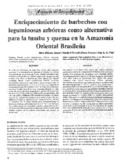Enriquecimiento de barbechos con leguminosas arbóreas como alternativa para la tumba y quema en la Amazonía Oriental Brasileña
Alternative title
Fallow enrichment with leguminous trees as an alternative to slash and burn in the Eastern Brazilian Amazon
Description
3 tab. 5 ref. 4 pág.
Abstract
Se evaluó la producción de maíz (Zea mays), yuca (Manihot esculenta) y la acumulación de biomasa en sistemas de cultivos intercalados que posteriormente fueron dejados para desarrollar barbechos enriquecidos con árboles leguminosos durante un ciclo agrícola (tres años) en Igarapé-açu, Pará, Brasil. Las especies evaluadas fueron Acacia angustissima, Clitoria racemosa, Sclerolobium paniculatum, Inga edulis y Acacia mangium, bajo los siguientes espaciamientos: 1 x 1, 2 x 1 y 2 x 2 m con excepción de S. paniculatum que sólo se plantó a 2 x 1 m. Hubo una tendencia a aumentar el peso seco de la yuca cosechada después de ocho meses de asocio conforme disminuyó el número de árboles por hectárea: 2 x 2 (7140 ¦ 200), 2 x 1 (6660 ¦ 220), testigo (6060 ¦ 780) y 1 x 1 m (5610 ¦ 300 kg ha-1). El crecimiento en altura y diámetro (dap) de A. mangium fue mayor a los 24 meses (7.1m y 5.6 cm), seguido de I. edulis, A. angustissima y C. racemosa (3.4 m y 3.0 cm). A. mangium fue la mejor especie para enriquecimiento de barbechos (biomasa aérea total entre 51 y 62 t ha-1 a los 29 meses del establecimiento de los árboles), aunque el espaciamiento de 1 x 1 m debe ser cuidadosamente considerado debido a su potencial efectivo negativo en los cultivos intercalados aún durante su primer año. The production of maize (Zea mays) and manioc (Manihot esculenta), as well as the accumulation of biomass in intercropped systems that subsequently developed into improved fallows containing leguminous trees, was evaluated during one agricultural cycle (three years) in Igarapé-açu, Pará, Brasil. The species evaluated were Acacia angustissima, Clitoria racemosa, Sclerolobium paniculatum, Inga edulis and Acacia mangium with the following spacings: 1 x 1, 2 x 1 and 2 x 2 m except with S. paniculatum that was only planted at 2 x 1 m and 29 months after tree establishment the trees and natural fallow vegetation were cut to measure above ground biomass. After 8 months association the harvested dry weight of manioc tended to increase when tree density decreased: 2 x 2 (7140 ¦ 200), 2 x 1 (6660 ¦ 220), control (6060 ¦ 780) and 1 x 1 m (5610 ¦ 300 kg ha-1). Height and diameter growth of A. mangium at 24 months was greater (7.1 m and 5.6 cm) followed by I. edulis, A. angustissima and C. racemosa (3.4 m and 3.0 cm). A. mangium was the best species for fallow enrichment (total above ground biomass between 51 and 62 t ha-1 29 months after tree establishment) although care is needed with 1 x 1 m spacing due to potential negative effects on intercrops even during the first year.
Keywords
Publisher
CATIE, Turrialba (Costa Rica)


